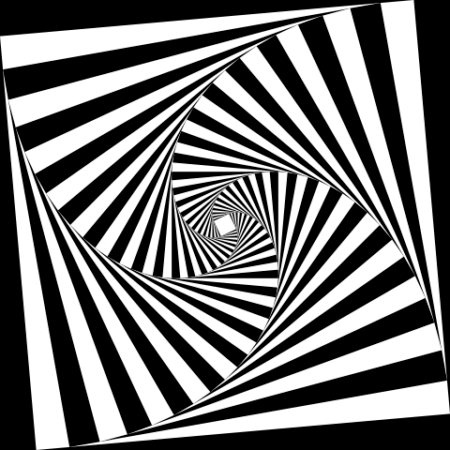This post aims at providing some intuition and meaning for the following algebra relationship:
Reduced ring – Radical ideal – Nilpotent
Reduced ring – Radical ideal – Nilpotent
A basic fact of ring theory is that if you take a ring ![]() and quotient it for a (double-sided) radical ideal
and quotient it for a (double-sided) radical ideal ![]() you get a reduced ring. Let us suppose A is a commutative ring and understand why this fact is true.
you get a reduced ring. Let us suppose A is a commutative ring and understand why this fact is true.
Nilpotent element
Def. ![]() is nilpotent
is nilpotent ![]()
Informally, a nilpotent element is like a road ending in the middle of nowhere, collapsing in the depth of an abyss. You are driving on it, following the powers of ![]() , and then all of a sudden, with no explanation, your road ends in a big black hole. Indeed, the zero really acts as some kind of black hole, attracting nilpotent-made roads at some point or another: we can think of nilpotent roads as spiraling into the zero.
, and then all of a sudden, with no explanation, your road ends in a big black hole. Indeed, the zero really acts as some kind of black hole, attracting nilpotent-made roads at some point or another: we can think of nilpotent roads as spiraling into the zero.
Reduced ring
Def. ![]() is a reduced ring if the only nilpotent is
is a reduced ring if the only nilpotent is ![]() .
.
With the road-analogy, we can think of a reduced ring as a city where all roads lead somewhere and never end in a giant hole. We can see how desirable it is to have a reduced ring rather than a non-reduced one, because it is not nice to pick a road and end up in the rabbit hole unexpectedly. However, it is worth noting that there still is one hole corresponding to the zero element, but this is not exactly a road since it does not even start, let alone have the intention to bring you anywhere.
The way I imagine a reduced ring is like a big hole in the middle of a city, with roads going around in circles or in straight lines crossing the city, but never getting through the big hole in the center.

Given the premises, we now ask two questions:
- Given a quotient ring, is there any way can we say it is reduced?
- Given a ring, is there any way we can get rid of its nilpotents? If yes, what’s the best way to do that?
1. Reduced property for quotient rings
To inspect whether a quotient ring is reduced or not, it is possible to inspect the ideal that was used to form the quotient [1]. This is useful when dealing with a quotient which you know the genesis of: if you know what ideal was used to quotient what ring, then it’s easier to inspect the ideal properties rather than the quotient ones, which are usually difficult to deal with.
Now, the proof of the theorem stating that a radical ideal gives rise to a reduced ring is quite straightforward, but the intuitive reason why it happened eluded me at first. Let me share my intuitions.
Radical ideal
Def. ![]() is a radical ideal
is a radical ideal ![]()
Or, in words, if, taken an element in ![]() , the presence of some power of the element in
, the presence of some power of the element in ![]() guarantees its presence in
guarantees its presence in ![]() . You could also see a radical ideal as containing the root of all its elements.
. You could also see a radical ideal as containing the root of all its elements.
The reason why using a radical ideal to form a quotient gives a reduced ring as result is actually quite straightforward to the point that it is wonderful. As Hamed points out, every ideal contains zero! But zero is a power of any nilpotent element (look again at the definition, there must be a power of ![]() for which
for which ![]() is zero), so indeed there always is at least a power of each nilpotent element in a radical ideal, because all nilpotent elements turn to zero at some point. But thanks to the radical ideal definition, we know that if some power of an element is in the ideal, so does its base!
is zero), so indeed there always is at least a power of each nilpotent element in a radical ideal, because all nilpotent elements turn to zero at some point. But thanks to the radical ideal definition, we know that if some power of an element is in the ideal, so does its base!
So we have an ideal which, for sure, contains at least all nilpotent elements. Thus, when we form a quotient with that ideal, we are identifying all its elements with zero. That’s why nilpotents vanish with a radical ideal, and I find it amazing that it all comes from the fact that all ideals contain zero and, of course, from the definition of radical ideal.
The question one may ask is: right, but are we getting rid of nilpotents only? Isn’t there the risk of affecting non-nilpotent elements? And indeed, it is true than being a radical ideal guarantees that the quotient is reduced, but it doesn’t guarantee that we have got rid of the nilpotent elements only, and some innocent element of ring has not been destroyed in our zeal of building the perfect city. In other words, we may be using a bazooka to shoot a fly! Let’s see if we can refine our doings and come up with a good way of doing this.
2. Build a reduced ring from an ordinary one
We have got to our second question: given an ordinary ideal ![]() , are we capable of building another ideal
, are we capable of building another ideal ![]() that is reduced and yet as similar as possible to
that is reduced and yet as similar as possible to ![]() (i.e. doing the smallest damage possible to
(i.e. doing the smallest damage possible to ![]() )?
)?
Yes we can, and, surprisingly, we already have roughly all ne need. Only thing we are lacking is the definition of the radical of an ideal.
Radical of an ideal
Def. Given ![]() an ideal, then its radical is
an ideal, then its radical is
![]()
From what we have said earlier, we will need an ideal which (at least) contains all nilpotents. It turns out that taking the radical of the ![]() ideal does the job!
ideal does the job!
In fact, ![]() is exactly what we are looking for!
is exactly what we are looking for! ![]() is a ring which is as close to
is a ring which is as close to ![]() as we can get, and yet does not have any nilpotent elements!
as we can get, and yet does not have any nilpotent elements!
Getting back to the city-road-holes analogy, it seems like we are able to make the nilpotent spiral-made roads collapse into the zero, thus destroying that fake road!
Going farther: null-divisors – reduced ideal – domain and non-invertible – maximal ideal – field
I’ve detailed the intuitions on the reasons why a ring modulo a reduced ideal gives a domain[2] and (some bit) why a ring modulo a maximal ideal gives a field on math.stackexchange.com.
Footnotes
1. Inspecting a quotient properties by looking at the ideal used to quotient doesn’t seem very interesting to me, as I can’t see a valid real-world reason to inspect the properties of a quotient (and even if there were, I don’t believe the ideal used to quotient would be known explicitly). I don’t know, it all seems done just to create exercises to solve in exams, so the second question looks much more interesting for me.
2. It’s worth noting that in this case, there is not a unique, best choice for the ideal that will build the domain ring. For example, in ![]() , both
, both ![]() and
and ![]() are good choices (in fact, equivalent choices).
are good choices (in fact, equivalent choices).
